
Under the arches of the porticoes in Portofino and at many of the street doors the workers-from little girls of six to wrinkled dames of seventy- sit in front of the three-legged stands which support the pillows on which their work is produced, and on all sides you hear the click of their wooden bobbins. To an uninitiated onlooker, the dexterity of the more accomplished workers seems magical: he marvels at the rapidity with which the bobbins fly from side to side of the complicated pattern, at the unerring exactitude with which just the right ones are selected, and wonders that the innumerable threads never become entangled amidst such a forest of pins. During the season for visitors, the streets are hung with lace; stalls, bearing every article of feminine adornment that can be made on a tombola, are erected on the piazza and at all the points where prospective buyers are likely to pass; so that how to get by without stopping to admire and purchase becomes a most difficult problem.
The fair young lace-makers invite you with such pleasant smiles and in so sweet a voice “merely to look” that it seems unmannerly to hasten away without accepting the invitation, and when you find that the price of their beautiful work is less than would satisfy the most unskilled of city toilers, you rarely resist the temptation to buy lace collars and handkerchiefs for your friends across the seas.
Three principal kinds of lace are now made at Portofino: antique, Byzantine, and Venetian.
The first original Portofino point, somewhat resembles torchon in appearance, and is very effective when employed for large pieces, such as scarves, blouses, coats, and table-covers. Byzantine, which is rather closer in design, has a characteristic raised knot which distinguishes it from any other lace of the neighbourhood; whilst Venetian, as its name implies, recalls the well-known Venetian point. It is a charming pattern of complicated scrolls united by fine bars, and is equally suitable for an entire lace coat or a delicate lace handkerchief. Of the three, it is much the longest to execute, and is a pattern which only the older and more experienced workers seem able to undertake. The little children of Portofino make much narrow edging and insertion, all partaking somewhat of the character of torchon, and a good deal of guipure, largely employed for the trimming of household linen, is also produced by young girls.
Portofino is the terminus of a very good road which winds along the coast to Rapallo by way of Santa Margherita Ligure, passing many points of exceptional beauty and historic interest.
With a rocky hillside above and precipitous descents into the sea below, you quickly come within sight of the little bay and castle of Paraggi, which, standing on an eminence above the sea, has been transformed by its fortunate owner, actually the Italian Premier Silvio Berlusconi, into a most charming villa. The road cuts through the rock at the base of this residence, passes beneath the wooded heights on which the Convent of Cervara, photo above, is built, and then gradually descends to Santa Margherita. The Convent of Cervara was founded in 1324 by Guido Scetten, Archbishop of Genoa, and is noteworthy as having been the temporary resting-place of two distinguished persons Pope Gregory XI, in 1376, whilst on his way from Avignon to Rome, and Francis I, who was imprisoned there in 1525, after the Battle of Pavia.
Portofino, a World apart.
